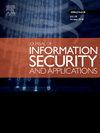基于FFST和Daisy描述符的医学图像鲁棒零水印方法
IF 3.7
2区 计算机科学
Q2 COMPUTER SCIENCE, INFORMATION SYSTEMS
Journal of Information Security and Applications
Pub Date : 2025-08-16
DOI:10.1016/j.jisa.2025.104193
引用次数: 0
摘要
随着数字医学成像技术的不断发展,确保医学图像的安全性变得至关重要。在这项研究中,Daisy描述符对攻击的稳定性进行了首次实验,结果表明它提供了优越的鲁棒性。在此基础上,结合快速有限Shearlet变换(FFST)、Daisy描述符和Hessenberg分解,设计了一种鲁棒的零水印方法,以保持医学图像的完整性并实现版权保护。首先,对医学图像进行FFST提取低频分量,并将其分割成大小相等的块。其次,计算每个块的Daisy描述符矩阵并选择其8x8块,然后对每个块进行Hessenberg分解,通过每个块的最大值与全局均值的幅度比较得到特征图像。此外,版权图像首先使用二维logistic -正弦耦合映射进行加密,然后通过排他或操作与特征图像结合,产生不可识别的二值图像。在10张医学图像和3个基准图像数据库(COVID-19、OASIS-1和SIPI)上的实验结果表明,该方法对大多数攻击具有较强的抵抗能力,归一化相关系数始终保持在0.95以上。与典型方法相比,我们的方法具有更好的鲁棒性,平均性能提高了约3.2%。本文章由计算机程序翻译,如有差异,请以英文原文为准。
Robust zero-watermarking method for medical images based on FFST and Daisy descriptor
With the continuous development of digital medical imaging technologies, ensuring the security of the medical images has become critically important. In this study,the Daisy descriptors’ stability against attacks was first experimented with, and the findings show that it provides superior robustness. With this, a robust zero-watermarking method is designed to maintain medical image integrity and enable copyright protection by combining the fast finite Shearlet transform (FFST), Daisy descriptor, and Hessenberg decomposition. First, FFST was performed on the medical image to extract the low-frequency component and divide it into blocks of equal size. Second, each block’s Daisy descriptor matrix is calculated and its 8 8 block is selected, after which the Hessenberg decomposition is performed for each block, and a feature image is derived from the magnitude comparison between the maximum value of each block and the global mean. Additionally, the copyrighted image is first encrypted by using a 2D Logistic-Sine coupling mapping, and then combined with the feature image through an exclusive OR operation to produce an unrecognizable binary image. The experimental results on ten medical images and three benchmark image databases (COVID-19, OASIS-1, and SIPI) show that the proposed method is highly resistant to most attacks, and the normalized correlation coefficient is always maintained higher than 0.95. Compared to typical methods, our method achieves superior robustness and improves the average performance by approximately 3.2%.
求助全文
通过发布文献求助,成功后即可免费获取论文全文。
去求助
来源期刊

Journal of Information Security and Applications
Computer Science-Computer Networks and Communications
CiteScore
10.90
自引率
5.40%
发文量
206
审稿时长
56 days
期刊介绍:
Journal of Information Security and Applications (JISA) focuses on the original research and practice-driven applications with relevance to information security and applications. JISA provides a common linkage between a vibrant scientific and research community and industry professionals by offering a clear view on modern problems and challenges in information security, as well as identifying promising scientific and "best-practice" solutions. JISA issues offer a balance between original research work and innovative industrial approaches by internationally renowned information security experts and researchers.
 求助内容:
求助内容: 应助结果提醒方式:
应助结果提醒方式:


